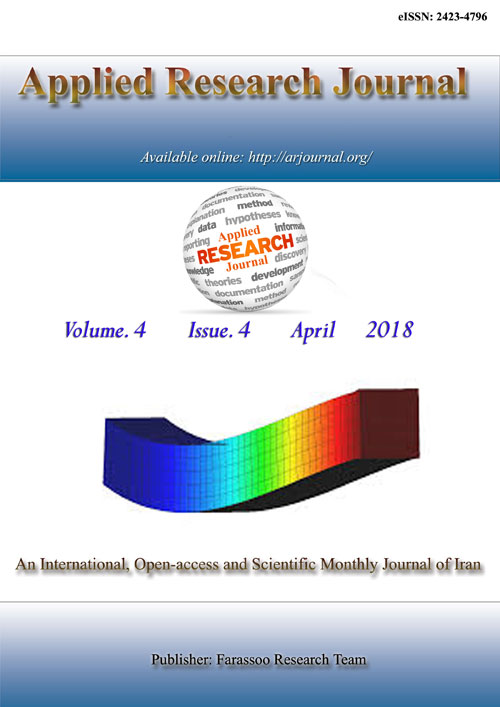فهرست مطالب
Applied Research Journal
Volume:2 Issue: 6, Jun 2016
- تاریخ انتشار: 1395/04/14
- تعداد عناوین: 4
-
Pages 266-274The purpose of this work is to study the effect of the difference intercritical annealing temperatures, which produce dual-phase microstructure of ferrite and various percentages of martеnsite volume fractions (MVF) in dualphase steel, and its influence on microstructure and mechanic properties. Dual phase steel (DPS) was developed from low carbon steel, which has good machinability using an intercritical annealing heat treatment. The intercritical annealing made by water quenching low carbon steel from three different temperatures (740, 760, and 780 ºC) to obtain different martensite volume fraction (MVF). The microstructure of (DPS) resulting after intercritical annealing contains bands of martensitic isles formed around the ferrite grains. The martinsite volume fraction increases by increase the temperature of intercritical annealing treatment. Dual phase steel showed large improvement in hardness and tensile properties with increasing martensite volume fraction. Also fatigue strength, and endurance limit increase with increasing (MVF). While wear resistance improved at (760 and 780 ºC) and decrease at (740 ºC).Keywords: Dual phase steel, Intercritical annealing, Martensite volume fraction (MVF), Low carbon steel
-
Pages 275-282Fatigue cracking is a serious distress associated with flexible pavements, it reduces the service life of the pavement. Fatigue damage of asphalt concrete is the amount of energy dissipated in the specimen during testing. Fatigue could be minimized by controlling the dissipated energy; which can be used to explain the decrease in mechanical properties, such as flexural stiffness. During dynamic-load repetition, amount of energy is carried into the material. Part of this energy is stored in the material and dissipated when the load is released. In this research, an investigation was made to monitor the changes in dissipated energy through the fatigue resistance process of asphalt pavement. Repeated four-point flexure bending beam test in controlled strain mode has been implemented. Asphalt concrete mixtures were prepared using different percentages of asphalt cement. Asphalt concrete slab samples of (300x 400x 60) mm were prepared using roller compaction, beam specimens of (400x 50x 60) mm were cut from the slab samples. Beam specimens were divided into two groups, the first group was directly tested for fatigue life using Nottingham four point bending beam device under the influence of three levels of micro strain (750, 400 and 250), at 5, 20, and 30 °C , while the second group was subjected to moisture damage impact before testing for fatigue life. During testing, dissipated energy per cycle was monitored through the changes in mix behavior and damage accumulation. The impact of asphalt content, strain level, and testing temperature on dissipated energy was discussed and compared.Keywords: Asphalt concrete, dissipated energy, moisture damage, fatigue
-
Pages 283-292Torsion rarely occurs by itself only. It is usually combined with other actions such as flexure and shear. Even-though, the performance of high strength reinforced concrete continuous beams under pure torsion is investigated in this study. Torsional moments were acted at the external supports via applying external loads far away from the vertical plane of bending at various eccentricities from the axis of the RC beams until failure. Variables considered in this study are absolute vertical displacement of the external supports, torsional moments capacity, and angle of twist and initial cracking stages of loading. Four increments of 10 cm in each of loading eccentricity started from 30 cm arm of loading were investigated. According to experimental results; when applied load eccentricity increased from 30cm to 60cm, the absolute vertical displacement increased about 56.315% and the angle of twist increased about 55.44% at failure while the generated twisting moments increased about 25.58% . It has been also found that the ultimate failure loading capacity of beams decreased about 37.21% when the load eccentricity increased from 30cm to 60cm. Furthermore, the initial cracking was monitored; it was found that cracking occurs at higher stages of loading with low loading eccentricity. The initial cracking records appeared at 79.07%, 77.78%, 74.3% and 66.67% of loading when loads arm were 30, 40, 50 and 60cm, respectively.Keywords: High strength concrete, continuous beam, pure torsion, absolute vertical displacement, angle of twist
-
Pages 293-300The need to produce high performance concrete led the researches to try to exploit the potentialities of natural or artificial materials in order to modify the performance of concrete in one hand and replacement part of cement by slag. Slag has been used as a substitute of part of cement after being processed, since its main oxides are similar to those of cement. In this investigation, the effect of steel slag was studied including finesses, consistency, initial and final setting time as well as compressive strength in(7, 28, 90 ) days and absorption of mortar in (7, 28) days were investigated. Results demonstrated that the inclusion of 20% slag as a partial replacement by cement weight showed superior performance over those of the other mixture of steel slag cement, Where the compressive strength after 90 days to replacement case (20%) becomes (40MPs ), and the reduction in water absorption in all cases except at (60%,80%) of replacement.Keywords: Portland Cement, Steel Slag, Partial Replacement, Mortar, Compressive Strength


